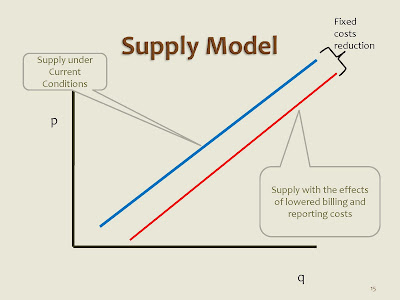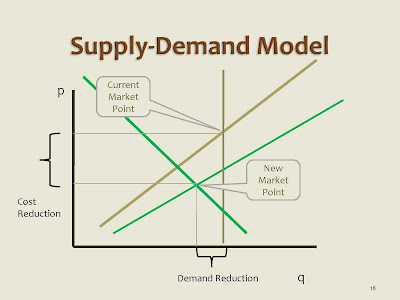
We have been doing a great deal of work on Healthcare, again, since 1993 and the old Hillary Health care program. This note is a simple way to look at what can be done in a set of basic economic concepts. It takes five slides.
Let us start with demand. We show it here. Note that in today's current market the demand is fixed and there is no elasticity with a price. You just go in and get it fixed, rich or poor, and then someone pays the bill. If you are unlucky enough to not have insurance and not be really really poor, you get a bill, a large and distorted bill.
Now if we use the proposed "carb tax" or the "butt tax" we discussed before we can place some elasticity in the demand as we show in the curve.
Now let us look at supply, a costly process.
 Here we show the current supply curve and then we show one which is dropped below it because we have managed to implement a program to reduce billing and record keeping costs. The cost per patient for the same units delivered is now reduced thus shifting down the supply curve, and reducing costs.
Here we show the current supply curve and then we show one which is dropped below it because we have managed to implement a program to reduce billing and record keeping costs. The cost per patient for the same units delivered is now reduced thus shifting down the supply curve, and reducing costs.Now let us look at another option. This is in the third graph.
 Here we have a change in supply by incorporating a scale economy effect such as one which can be effected by replacing the ER room with a Public Health system for those on the lower end of the economic scale. Yes this means different levels of care for those who pay, but we have that today. There are physicians on Park Avenue who accept no insurance and demand cash up front. And if you want to see them now you pay and added fee. It exists and it works.
Here we have a change in supply by incorporating a scale economy effect such as one which can be effected by replacing the ER room with a Public Health system for those on the lower end of the economic scale. Yes this means different levels of care for those who pay, but we have that today. There are physicians on Park Avenue who accept no insurance and demand cash up front. And if you want to see them now you pay and added fee. It exists and it works.Now we can combine these two to see what the total new Supply curve looks like, moved down and with a lower slope.
Now let us add the Demand and supply.

 This gives the last chart. Not we have a new market point of dramatically lower costs and a somewhat smaller set of services. This is an example of how to think about solving the Healthcare dilemma. No, I did not even mention who pays and what the role of the Government should be. Perhaps our economics wizards in the White House could think a bit more along these lines, not just spending more, but targeting improvements for all!
This gives the last chart. Not we have a new market point of dramatically lower costs and a somewhat smaller set of services. This is an example of how to think about solving the Healthcare dilemma. No, I did not even mention who pays and what the role of the Government should be. Perhaps our economics wizards in the White House could think a bit more along these lines, not just spending more, but targeting improvements for all!



